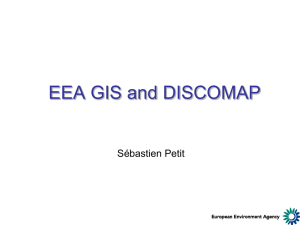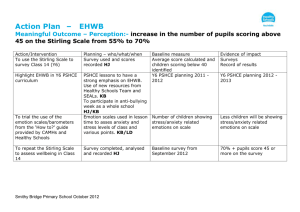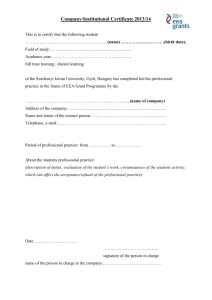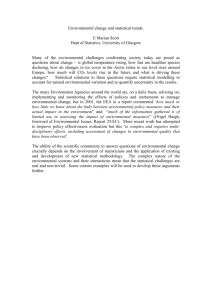NRC_EH_FRESH_brainstorm_session
advertisement
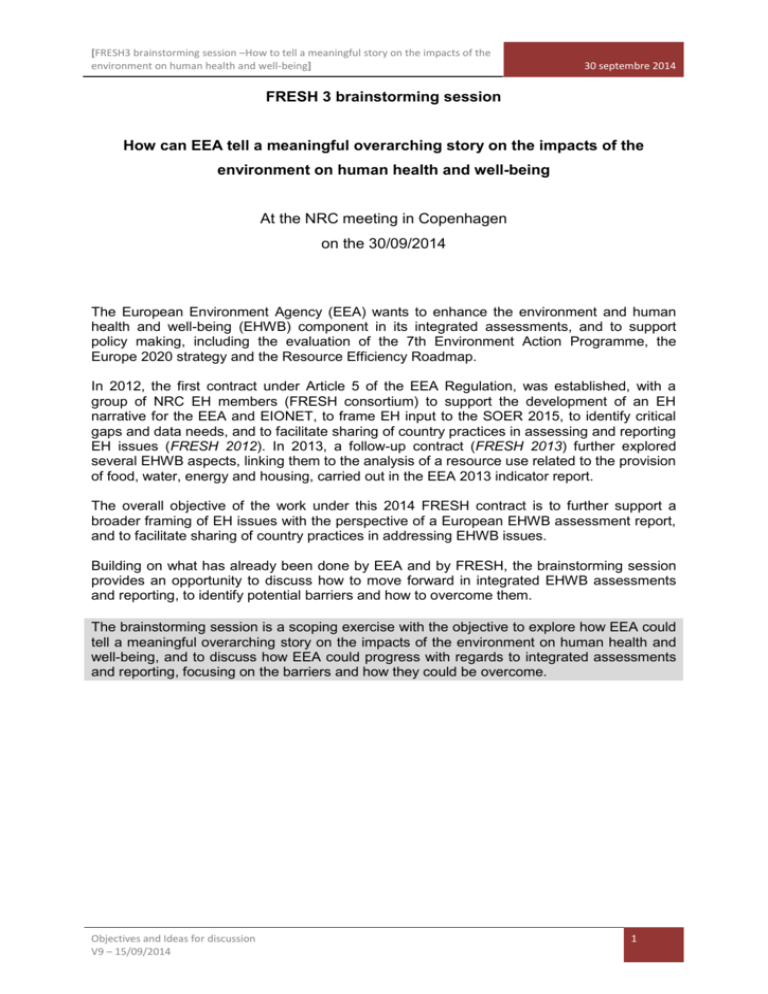
[FRESH3 brainstorming session –How to tell a meaningful story on the impacts of the environment on human health and well-being] 30 septembre 2014 FRESH 3 brainstorming session How can EEA tell a meaningful overarching story on the impacts of the environment on human health and well-being At the NRC meeting in Copenhagen on the 30/09/2014 The European Environment Agency (EEA) wants to enhance the environment and human health and well-being (EHWB) component in its integrated assessments, and to support policy making, including the evaluation of the 7th Environment Action Programme, the Europe 2020 strategy and the Resource Efficiency Roadmap. In 2012, the first contract under Article 5 of the EEA Regulation, was established, with a group of NRC EH members (FRESH consortium) to support the development of an EH narrative for the EEA and EIONET, to frame EH input to the SOER 2015, to identify critical gaps and data needs, and to facilitate sharing of country practices in assessing and reporting EH issues (FRESH 2012). In 2013, a follow-up contract (FRESH 2013) further explored several EHWB aspects, linking them to the analysis of a resource use related to the provision of food, water, energy and housing, carried out in the EEA 2013 indicator report. The overall objective of the work under this 2014 FRESH contract is to further support a broader framing of EH issues with the perspective of a European EHWB assessment report, and to facilitate sharing of country practices in addressing EHWB issues. Building on what has already been done by EEA and by FRESH, the brainstorming session provides an opportunity to discuss how to move forward in integrated EHWB assessments and reporting, to identify potential barriers and how to overcome them. The brainstorming session is a scoping exercise with the objective to explore how EEA could tell a meaningful overarching story on the impacts of the environment on human health and well-being, and to discuss how EEA could progress with regards to integrated assessments and reporting, focusing on the barriers and how they could be overcome. Objectives and Ideas for discussion V9 – 15/09/2014 1 [FRESH3 brainstorming session –How to tell a meaningful story on the impacts of the environment on human health and well-being] I. 30 septembre 2014 Introduction and concepts Environment Ecosystems, Positive and / or (artificial and natural) space, mobility, negative (Fauna, flora, air, water, soil, noise, waste, life cycle ...) cycles that respect Biodiversity, Green environmental the environment, impact on ethical production, Health Well-being (life expectancy, Health care systems, Access to health care, genetics, prevention, screening ... ) (economics, exchanges, social integration, societal expectations, socio-economic development, sustainability ...) health... sustainable development … Ability to envisage a future, personal development and human relations in a secure environment, reproduction … Urbanisation, transport, physical activity, nutrition, perception, adaptation, satisfying one’s needs, quality of life, leisure activities ... Figure 1: EHWB concept in the context of the WHO definition of health1 EHWB is a complex issue and many interactions are at play. Human health and well-being are influenced by environmental conditions both positively and negatively with significant economic and social consequences. On the opposite side, economic and social development interact with the environment, human health and well-being. The interfaces between these various elements, such as technologies and resource availability are the areas that need to be further understood and documented in order to support a broader framing of EHWB issues. Nowadays, it is necessary to consider human social complexity in the relationship between people and their environment; the positive potential of good environments; the psychosocial dimension and the ecological dimension. Work on such an ecosystems approach and linking environment to health has already been done (for instance in the joint EEA/JRC environment and health report – in particular part III on analytical and policy considerations), and the EEA 2013 environmental indicator report where big environment themes on resource efficiency were linked to environment and health. Reversing the entry points, by placing human health and well-being concerns in the centre and starting from the population and then looking at how things pan out from an integrated perspective, would bring added-value to this work and help identify the challenges in bringing in an integrated approach to the EEA SOER. 1 The WHO definition: “Health is a state of complete physical, mental and social well-being and not merely the absence of disease or infirmity” leads to a positive approach to health and a global approach to health. In this case, the environment is meant in the wide sense, including artificial and natural environments within social, economic, cultural contexts . Objectives and Ideas for discussion V9 – 15/09/2014 2 [FRESH3 brainstorming session –How to tell a meaningful story on the impacts of the environment on human health and well-being] 30 septembre 2014 A recently articulated model which seeks to integrate considerations of ecosystem health, human health and wellbeing is the ‘ecosystems enriched DPSEEA’ (eDPSEEA) model (Reis S, Morris G et al., 2013) (see Figure 2). The model represents the proximal and distal relationship between environment and human health. The eDPSEEA model builds on the DPSEEA/mDPSEEA models used by the WHO to better reflect the health and wellbeing implications of ecosystems change. Figure 2 Ecosystems enriched DPSEEA model The conceptual framework is designed to enable discussions on these issues and can be used in a number of ways: - - As a basis for reflection to help identify interactions between various factors to describe and analyse baseline situations to evaluate where policy should be focused, to evaluate the impact of policy interventions (or lack of), or to derive and test targeted policy interventions (or assess inaction) aimed at reducing identified gaps and improving EHWB. Policies can then be bent and tuned in a more integrated, rather than sectorial, way. To define relevant indicators for policy makers and stakeholders. It can be applied at different levels: local, regional, national or international. . Objectives and Ideas for discussion V9 – 15/09/2014 3 [FRESH3 brainstorming session –How to tell a meaningful story on the impacts of the environment on human health and well-being] 30 septembre 2014 As can be seen in the results of the FRESH 1 and 2 projects, one key element is to achieve a readable description of these interfaces. In a second step, these interactions and the positive levers and links to policy agendas and measures that impact our environment are examined. Associated to this framework, case studies or narratives can also be identified and developed to illustrate specific interlinkages. For example, demographic developments and environmental change clearly dictate the focus of environment and health policy on the urban residential area. The implications of rapid urban growth include unemployment, environmental degradation, lack of urban services, overburdening of existing infrastructures and lack of access to land, finance and adequate shelter. Managing a sustainable urban residential environment becomes one of the major challenges for the future especially when balancing the different parameters including waste discharge and resource consumption. This was for example developed in the FRESH projects with the narrative ‘Cities in Transition: Challenges and Opportunities for the Elderly’. However, the principles can be applied across the field of modern public health. Narratives can help identify the priority focus of environment and health policies at the three distinct levels or spheres: cities (macro), neighbourhood (meso) and households/Individuals (micro). The work in FRESH also touched upon what should be done differently to operationalise this overarching EHWB approach: the policies, indicators, approaches to issue framing, institutional arrangements, governance etc. The brainstorming session is also an opportunity to look into these in more detail when discussing the overarching issue: the assessment, reporting and communication of EHWB impacts. Figure 2: Example narrative illustration of interlinkages II. Brainstorming session Introduction: The brainstorming sessions will facilitating the EEA in scoping issues in the field of human health and well-being. To do this the context of EHWB and FRESH concept will be presented to provide a shared understanding of the conceptual framework in FRESH and highlight important EHWB issues. In the brainstorming session, we aim to discuss how EEA could tell a meaningful overarching story on the impacts of the environment on human health and well-being, in particular to Objectives and Ideas for discussion V9 – 15/09/2014 4 [FRESH3 brainstorming session –How to tell a meaningful story on the impacts of the environment on human health and well-being] 30 septembre 2014 discuss how EEA could progress with regards to integrated assessments and reporting, focusing on the barriers (and how they could be overcome) and the opportunities. Methodology: After a plenary session aiming at presenting the FRESH concept and “overarching framework”, and discussing how to include the approach in further environmental health assessments, working groups will be created. They will be dedicated to the parallel development of the approach on different topics, always putting health and well-being in the centre, providing 3 stories using a common methodology and common boundary conditions. Program: During the introduction to the working group discussions, the generic diagram (“the overarching framework” will be presented and some boundary conditions or evolution drivers will be determined which should be taken into account by all groups. These include the: - Health determinants, Ecological dimension Socio-demographic and economic drivers Emerging trends and future developments NRC members will then be split into different parallel working groups who will unravel the approach on three different themes (still to be determined but e.g. housing, food and water, transport, sustainable energy) during three discussion sessions: 1. Tools to think with: built on the conceptual framework: To create a more detailed framework starting from the FRESH conceptual model overview: moving from the classic environment-driven approach to the integrated solution placing EHWB and the health determinants as the entry point (thinking about and discussing the issues and populating the model). 2. To analyse the context and identify critical points for indicators or where they need further development. 3. To discuss policy developments and tell the story by assembling the framework and indicators into case studies (positive stories where actions and levers have an impact) and identify barriers. A final plenary session will bring the three groups together to present the results of their discussion (their story), each group will have 5 minutes tell a convincing story. The final plenary will also be used to cross the ideas arising from the discussions, and the reasons for the choices made (e.g. why certain issues and cases were not included), looking at the barriers identified and how they could be overcome. Output: The output will be three different thematic stories with illustrative case-studies translating the conceptual framework and important EHWB issues into practice. The discussions and maps of the framework and interactions and critical points identified for indicators and levers (policy developments) will also be reported. Objectives and Ideas for discussion V9 – 15/09/2014 5 [FRESH3 brainstorming session –How to tell a meaningful story on the impacts of the environment on human health and well-being] 30 septembre 2014 Background material Preparation for the brainstorm session can be done by reading the FRESH 3 draft material/background documents: - General Brochure FRESH (draft) Narrative Brochure (FRESH1) FRESH 1 and 2 final reportsw29q Other useful background reading materials are: - EEA/JRC Environment and health report (part III) EEA 2013 environmental indicator report EEA – state and outlook 2015: draft E&H Chapter Objectives and Ideas for discussion V9 – 15/09/2014 6


